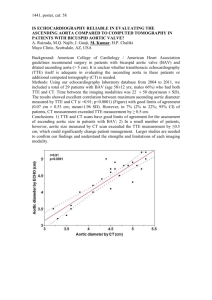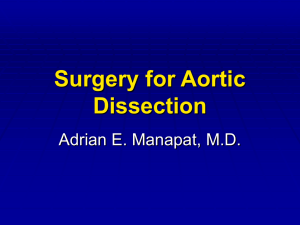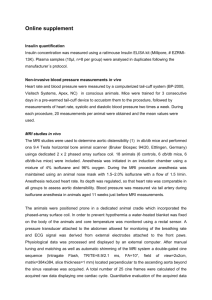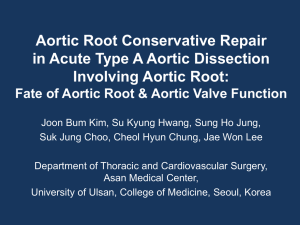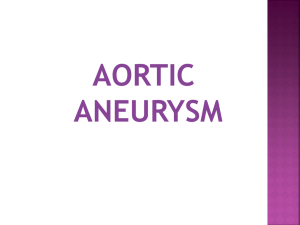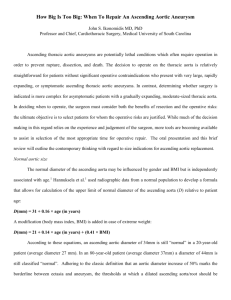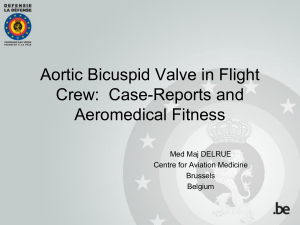Routine Hypothermia with Circulatory Arrest and Retrograde
advertisement
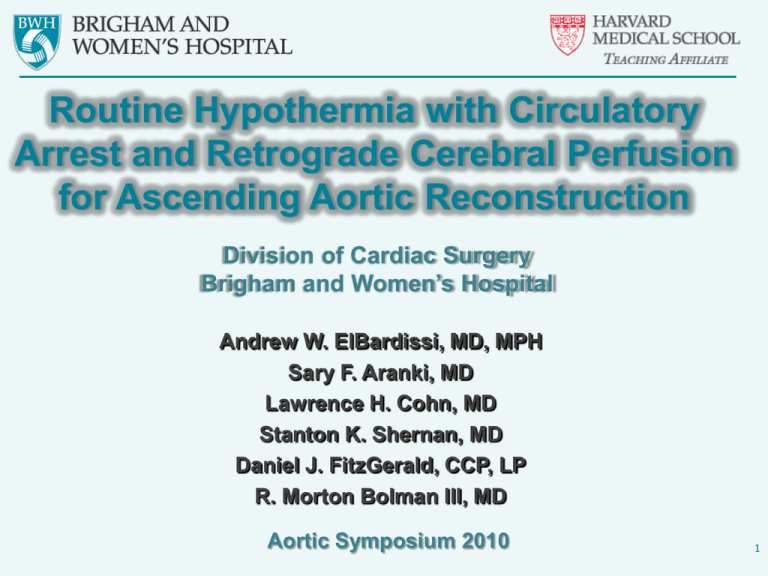
Routine Hypothermia with Circulatory Arrest and Retrograde Cerebral Perfusion for Ascending Aortic Reconstruction Division of Cardiac Surgery Brigham and Women’s Hospital Andrew W. ElBardissi, MD, MPH Sary F. Aranki, MD Lawrence H. Cohn, MD Stanton K. Shernan, MD Daniel J. FitzGerald, CCP, LP R. Morton Bolman III, MD Aortic Symposium 2010 1 Natural History of Aneurysmal Disease 2 Background •Aneurysmal ascending aortic degeneration includes aortic tissue proximal to the innominate artery •Aortic cross-clamping leaves a segment of aneurysmal distal ascending aorta 3 Surgical Result following Reconstruction Closed Distal Anastomosis Open Distal Anastomosis 5 Objective •Evaluate outcomes of elective ascending aortic reconstruction with open distal anastomosis (with RCP) versus closed distal anastomosis with aortic crossclamping. 6 Methods 687 patients with Ascending Aortic Reconstruction (2005-Present) Aortic Dissections Complex aortic arch reconstructions 305 patients 195 closed distal (CD) anastomosis 110 open distal (OD) anastomosis with RCP 1:1 Propensity Matching 99 CD 99 OD 7 Methods • Primary endpoint – CVA – Temporary Neurologic Deficit – Ventilator Hours – ICU Hours – Length of Stay • Secondary endpoint – 30-day mortality – Intermediate-term Survival 8 Preoperative Characteristics Age Male Gender n(%) Caucasion n(%) Diabetes n(%) COPD n(%) Hyperlipidemia n(%) Hypertension n (%) Serum Creatnine History of CVA n(%) Previous MI n(%) CHF n(%) Angina n(%) NYHA Classification I II III IV OD (n=99) 60±12 76 (77%) 93 (94%) 5 (5%) 88 (89%) 49 (50%) 57 (57%) 0.98±.23 4 (4%) 4 (4%) 23 (23%) 16 (16%) 42 (42%) 40 (40%) 20 (20%) 0 (0%) Hemodynamic Data Normal sinus rhythm n(%) 87 (86%) Ejection Fraction 59 ±8 Mean PAP 23±7 Aortic Stenosis n(%) 29 (29%) Aortic Stenosis Gradient (mmHg) 35±17 CD (n=99) 61±12 72 (73%) 97 (98%) 6 (6%) 87 (88%) 55 (56%) 61 (62%) 1.1±0.4 6 (6%) 9 (9%) 24 (24%) 20 (20%) 37 41 20 1 p-value 0.6 0.52 0.39 0.76 0.83 0.39 0.56 0.17 0.52 0.15 0.86 0.46 0.43 (37%) (41%) (20%) (1%) 89 (89%) 57±13 22±8 37 (37%) 38±20 0.66 0.23 0.24 0.27 0.25 9 Operative Characteristics Reoperation n (%) CPB time (minutes) Cross-clamp time (minutes) DHCA Temperature (Celsius) DHCA Time RCP Time Concomitant Procedures Aortic valve replacement CABG OD (n=99) CD (n=99) 23 (23%) 18 (18%) 206±95 160±79 156±73 120±73 21 . 21±8 (11, 50) . 17±8 (3, 50) . 22 (22%) 24 (24%) 30 (30%) 19 (19%) p-value 0.38 0.0005 0.0006 . . . 0.55 0.39 10 Results P=0.44 80 2% P=0.42 70 P=0.57 60 RCP 1% CPB n=1 n=2 n=2 n=1 50 40 30 P=0.20 P=0.52 20 10 0 0% CVA (%) Ventilator Hours TND (%) ICU Stay (hours) Length of Stay (days) 1.00 0.95 P=0.30 0.90 No difference in 30 day (OD, 0% vs. CD, 1%, p=0.59) or Intermediate-term Mortality 0.85 0.80 0.75 0.70 0.65 0.60 0.55 0.50 0.00 300 900 Follow-up (days) 1200 Conclusions • Open distal reconstruction of ascending aorta in AAA repair – No difference in operative mortality, stroke, temporary neurologic deficit, ventilator hours, ICU hours, or LOS compared to closed distal with aortic xclamping – Should be considered as a routine treatment strategy, as it allows removal of AA in its entirety 12

